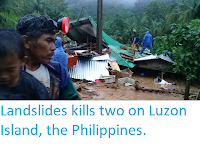At least 43 people have died and it is feared as many as 80 may have died after a flash flood hit the village of Dalama in Lanao del Norte Province on northern Mindanao Island, the Philippines, at about 11 am local time on Friday 22 December 2017. The flooding was caused by heavy rains associated with Tropical Storm Vinta (or Tembin), which caused the River Cabuyao to burst its banks, resulting in a flood of mud and water laden with rocks and trees destroying the majority of the 103 buildings there. Around 25 more people are thought to have died in other events associated with the storm in Lanao del Norte Province.
The site where the village of Dalama in Lanao del Norte formerly stood. Province of Lanao del Norte/Facebook.
Tropical Storm Vinta has caused widespread flooding in the Visayas, Mindanao and southern Luzon, and is currently heading towards. Palawan Island, where it is expected to make landfall within the next few hours. The storm is thought to have caused over a hundred deaths other than those in Dalama, with at least 47 dead in the province of Zamboanga del Norte on western Mindanao.
The path and strength of Tropocal Storm Vinta. Thick line indicates the
past path of the storm (till 9.00 pm GMT on Monday 11 September 2017),
while the thin line indicates the predicted future path of the storm,
and the dotted circles the margin of error at six and twelve hours
ahead. Colour indicated the severity of the storm. Tropical Storm Risk.
Tropical storms are caused by the warming effect of the Sun over
tropical seas. As the air warms it expands, causing a drop in air
pressure, and rises, causing air from outside the area to rush in to
replace it. If this happens over a sufficiently wide area then the
inrushing winds will be affected by centrifugal forces caused by the
Earth's rotation (the Coriolis effect). This means that winds will be
deflected clockwise in the northern hemisphere and anti-clockwise in the
southern hemisphere, eventually creating a large, rotating Tropical
Storm. They have different names in different parts of the world, with
those in the northwest Atlantic being referred to as hurricanes.
Flooding associated with Tropical Storm Vinta in Maranding in Lanao del Norte. ABS-CBN News.
Despite the obvious danger of winds of this speed, which can physically
blow people, and other large objects, away as well as damaging buildings
and uprooting trees, the real danger from these storms comes from the
flooding they bring. Each drop millibar drop in air-pressure leads to an
approximate 1 cm rise in sea level, with big tropical storms capable of
causing a storm surge of several meters. This is always accompanied by
heavy rainfall, since warm air over the ocean leads to evaporation of
sea water, which is then carried with the storm. These combined often
lead to catastrophic flooding in areas hit by tropical storms.
Flooding in Lanao del Norte. Aclimah Cabugatan Disumala/Reuters.
See also...
Follow Sciency Thoughts on
Facebook.










